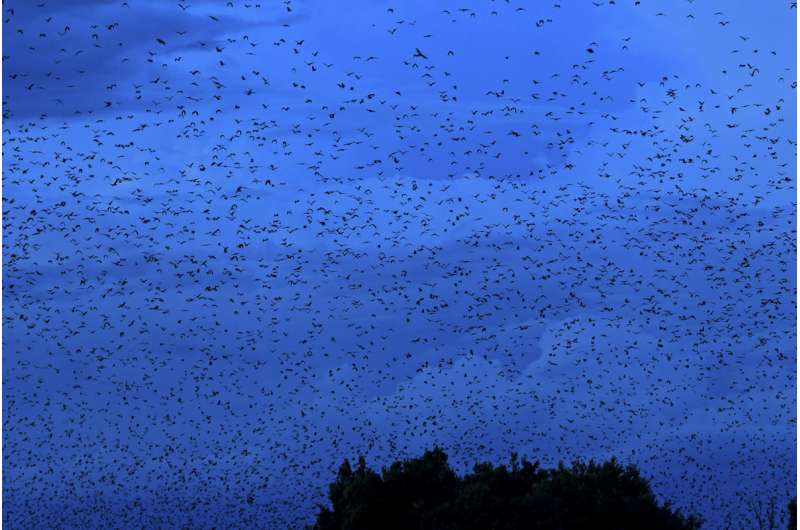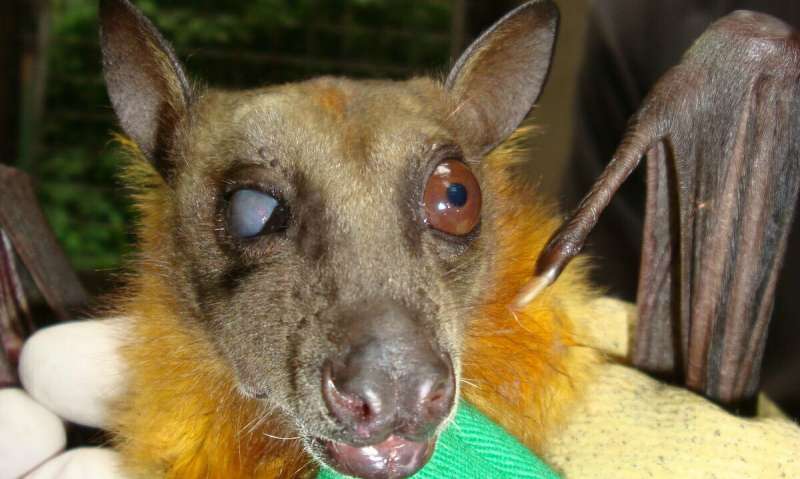Fruit bats are reforesting African woodlands

Not only do intact ecosystems delight the eye of nature lovers, they also help people financially. However, it is difficult to put an exact figure on how much money they actually generate in specific cases. For the first time, researchers at the Max Planck Institute for Ornithology in Radolfzell, together with their colleagues from Sweden and Ghana, have now calculated the ecological and financial benefits of straw-coloured fruit bats in Africa.
Every night, individuals of this bat species fly long distances to their feeding grounds in the course of which they disseminate the seeds of the fruits they consume. According to the researchers, a colony of 150,000 animals disseminate more than 300,000 small seeds in a single night. This is sufficient to kickstart the regrowth of 800 hectares of forest – for a single colony. Thus, both forests and humans could benefit from better protection for these creatures, which are primarily at risk from hunting.
Straw-coloured fruit bats (Eidolon helvum) have a wingspan of up to 80 centimetres and feed on nectar and fruit. They sleep during the day hanging upside down in the crowns of old trees, and become active at sunset when they set off in search of food. When these animals live in colonies and competition for food is stiff, they fly up to 95 kilometres to suitable fruit trees and only return to their roosts the following morning. They excrete the seeds of the fruit they consume in their droppings, disseminating them across huge areas as they go.
In this way, the fruit bats contribute to the species and genetic diversity of forests, which can only thrive if frugivores such as fruit bats provide seed dispersal services. Thanks to long-distance transportation by the bats, young trees can germinate and grow in environments where there is no direct competition from their conspecifics and away from herbivores specialised in their consumption. In this way, new forests can spring up even in cleared areas.

Flights over long distances
Together with her colleagues, Dina Dechmann of the Max Planck Institute for Ornithology in Radolfzell has been studying the straw-coloured fruit bats, which live in Africa, for years. "Most species of fruit-eating animals never leave the protective canopy of their forests, which is why they only disseminate seeds over a small area," Dechmann explains. During their nocturnal flights, by contrast, the straw-coloured fruit bats cross forest boundaries and open country, and can disseminate the seeds of consumed fruits over distances of up to 75 kilometres. They also eat many different kinds of fruit and live in colonies of thousands to millions of individuals.
The researchers used GPS transmitters to track the flight paths of the straw-coloured fruit bats, in addition to which they measured the time it takes to disseminate the seeds after ingestion in feeding experiments. These showed that the animals only excrete some of the seeds after a relatively long time, thereby facilitating their dissemination over vast distances.

Large-scale seed dispersal
With the aid of the data on flight movements and seed excretion periods, the researchers were able to calculate the potential of an entire colony to disseminate seeds over long distances and to transport them to deforested areas. By this means, they discovered that a colony of 150,000 straw-coloured fruit bats can disseminate more than 300,000 seeds in a single night.
"Among other things," Dechmann explains, "the straw-coloured fruit bats disseminate fast-growing trees, which create the right environment for other tree species to establish and grow." These are enough seed to to replant 800 hectares of forest per year in Ghana alone. The profit that the regrowth of this much forest generates for the population, for example through edible fruits, increased soil fertility and timber has been estimated to be in excess of 700,000 Euro. Because the straw-coloured fruit bats migrate throughout Africa, many communities profit from their services.
Hunting threatens populations
However, the population of straw-coloured fruits bats is in continuous decline. The bats are hunted in large numbers and sold in markets as food. However, logging the large trees in which the animals live is also threatening their populations. "That's an incredible loss," says Dechmann, "because the straw-coloured fruit bats contribute to the conservation of African forests, so there is an urgent need to explain their importance to the human population." A local king in Kibi, a town in Southern Ghana, is leading by example and has placed the straw-coloured fruit bat colony that has taken up residence in his garden under his own personal protection.
More information: Mariëlle L. van Toor et al. Linking colony size with quantitative estimates of ecosystem services of African fruit bats, Current Biology (2019). DOI: 10.1016/j.cub.2019.02.033
Journal information: Current Biology
Provided by Max Planck Society




















